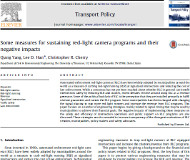8/13/2013
Study Evaluates Options For Increasing Red Light Camera Revenue University of Tennessee researchers examine techniques used to bolster revenue from automated ticketing machines.

Researchers at the University of Tennessee are concerned with the way some cities are using red light cameras. In a study published in the September issue of the journal Transport Policy, Professors Lee D. Han and Christopher R. Cherry explored the relationship between generating revenue and increasing safety in photo enforcement programs.
"A literature survey reveals that most municipalities implementing red light cameras are committed to private red light camera providers with certain revenue goals to financially sustain their red light camera programs," the study found. "Most red light cameras are installed with dual, conflicting purposes, reduce red light running and maximize private (and public) sector revenue from red light running citations. Harmonizing these two purposes is challenging, resulting in substantial backlash against red light cameras."
One of the strongest form of backlash comes when voters use the referendum process to overturn a city council's decision to implement photo ticketing. In nine out of ten cases, voters have rejected automated ticketing machines at the ballot box (view list). On the other hand, municipalities also face significant financial pressure from their local budget and from the private contractor that operates the camera program to keep citation issuance levels high.
The researchers cited four prior studies that concluded longer yellow timing reduced red light running and one study that confirmed shortening yellows increased red light running. The University of Tennessee analysis examined the upsides and downsides of adjusting signal timing, shortening cycle length, increasing speed limits and altering congestion levels to increase the number of citations issued.
"I think most traffic engineers would never yield to the pressure and re-time their signals at the cost of public safety just to generate revenue for their municipalities," Han explained in an email. "Nevertheless, as pointed out in this paper, there have been lawsuits resultant from traffic signal 'tampering,' which highlights the importance to call attention to this issue."
Glassboro, New Jersey, for example, admitted to having a short yellow that generated $1 million in tickets. The University of Tennessee study found that shortening yellow time while increasing the all-red period when all directions at an intersection are stopped (the clearance interval) is the most effective technique for increasing the number of citations issued without a major, negative impact on safety. The authors saw their review not as a how-to guide for municipalities, but a method to explore how enforcement programs nationwide are dealing with the challenge.
"[What] is far more important to me is to make the public, the consumer watchdogs, etc., aware of some ways traffic signals can and might be timed for purposes other than traffic safety and operational efficiency," Han explained.
The journal article is available for a price from Transport Policy.


